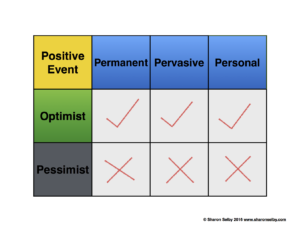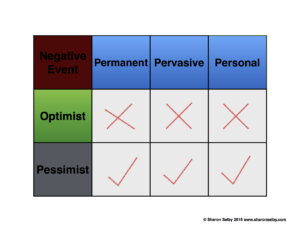
Some of us are more optimistic and some of us are more pessimistic. There’s some research which indicates that being optimistic or pessimistic is an in-born trait of our temperament.
Sometimes it is beneficial to be pessimistic as this allows for caution and time for realistic thinking. However, research states that optimists are more likely have better overall health, more positive relationships, achieve more and have more enjoyment in life. But there are times when being too optimistic can be detrimental. For example, holding onto a business idea and trying to make it work, even though it’s creating more and more debt.
What We Model Is A Big Influencer
Our thoughts create our feelings and our thinking patterns are often replicated from our parents.
Let’s break down the thinking patterns into two distinctly different explanatory styles, as researched by Dr. Martin Seligman, the author of The Optimistic Child and Learned Optimism.
Are You Optimistic or Pessimistic?
When a positive event happens, an optimistic thinker believes that this is permanent, pervasive and personal.
When a negative event happens, an optimistic thinker believes this is not permanent, not pervasive and not personal.
The reverse happens for a pessimistic thinker…
For a pessimistic thinker, when a positive event happens, a pessimistic thinker believes this is not permanent, not pervasive and not personal.
When a negative event happens, a pessimistic thinker believes this is permanent, pervasive and personal.
I’ve created two visuals below to summarize these two different explanatory styles. (To receive a pdf printable version of these two charts, please click here.) Also, keep reading, and you will come to a script that I’ve created to show you how to respond to a negative event by validating the negative emotions and sharing an optimistic explanatory style.


Think about how you and your family members interpret different events. Hopefully, you will now have a better understanding of the explanatory style which best fits you and each of your family members.
If you tend to be more optimistic, and have a pessimistic child, you may often try to get your child to be positive, feel positive and think positive, but without much success. Let’s discuss why…
Why Doesn’t It Work to Be Positive Around My Negative Child?
Remember the importance of feeling heard and understood? We all want to be accepted for who we are and we want our thoughts and feelings to be heard and understood, not dismissed.
Imagine if you came home from a tough day and told your partner or best friend that your day had been really rough, and he/she replied: “I’m sure it wasn’t that bad, tomorrow you’ll have a great day!”
Would this be the response that you were looking for? Probably not…
Therefore, we want to be compassionate, understanding and when the timing is right, be able to help our children realize that the bad events are not permanent, pervasive nor personal. We can do this by telling them to buck up and see the bright side, which will not be effective, or by having a thoughtful, caring conversation, which validates their feelings and helps them see things from an optimistic explanatory style.
Let’s go over an example of how to WEAVE in an optimistic explanatory style of responding:
Situation: Your child’s best friend has moved away and your child is missing this best friend.
Child: I used to always walk to school with Quinn.
Parent: Yeah, you really enjoyed your walks to school together. You miss not having her around.
Child: Yeah, I miss her a lot. I wish she still lived here.
Parent: I know, I’ve had friends move away before too and it is hard. It may not seem possible right now, but in time, there will be other friends who come into your life who will be as close to you as Quinn.
Child: I guess so.
Parent: I know Quinn was your best school buddy and you miss her a lot, but I do know that you have a lot of good buddies on the soccer team who always come up to you with a big smile on their face cause they’re happy to be around you.
Child: Yeah, I do really like the friends on my soccer team
Parent: I also know that Quinn’s parents didn’t really want to move but her Mom/Dad got a really good job opportunity and they felt as though it was too good of an opportunity not to take it. They do hope to move back here one day, and so they didn’t sell their house, instead they’ve rented it out so that they can hopefully move back one day.
Child: Yeah, that would be great if they come back one day.
Parent: In the meantime, I know you and Quinn have been face timing and her parents and I have been chatting about us all getting together next summer.
Child: That would be so much fun and I am glad that we can stay in touch through face time.
Do you see how the parent modelled optimistic explanations (without being too “sunny side”) to show that Quinn moving away…
- did not have to be a permanent end to the friendship
- was not a pervasive pattern that was happening with all of the child’s friends
- and the move was not personal
Furthermore, the parent explained that the strong feelings of missing Quinn would not last forever – these strong feelings would not be permanent.
I hope this gives you new insight as to how to validate your child’s emotions when they are negative, and also helps you have a discussion that incorporates an optimistic explanatory style.
For some children, they feel quite pessimistic and hesitant about starting a new school year with a new teacher and a different group of classmates, I hope this article will support you in supporting them.
Warmly,

PS. If you enjoyed this article and found it helpful, please share with your friends and family by forwarding or sharing on social media. I’d also love to hear your comments on my Facebook page. Thank you so much, I really appreciate it!
PPS. Remember to download the pdf images to put up on your fridge or bulletin board as to how to think with an optimistic explanatory style.
PPPS. Registration is open for my next round of “Brain Science” groups to teach children ages 7-9yrs. and 10-12yrs. about anxiety and anxiety management strategies. The 7-9yrs. group is sold out but you can join the waiting list. There’s still two spaces available in the 10-12 yrs. group. (These anxiety management groups will run again in January.) To register online, please click here and then click on “upcoming groups/events”.
Free Video On Developing Emotional Resilience
Want to Connect?
Subscribe now to receive free weekly parenting tips and inspiration.






